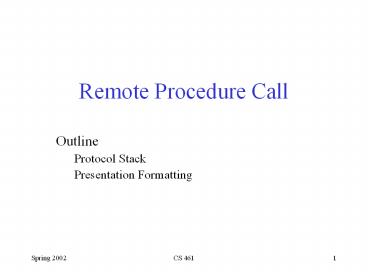Remote Procedure Call - PowerPoint PPT Presentation
Title:
Remote Procedure Call
Description:
SELECT: dispatches request to the correct process. Stubs. Caller (client) Client. stub ... Caller. SELECT. CHAN. call. call. deliver. send. Callee. SELECT. CHAN ... – PowerPoint PPT presentation
Number of Views:48
Avg rating:3.0/5.0
Title: Remote Procedure Call
1
Remote Procedure Call
- Outline
- Protocol Stack
- Presentation Formatting
2
RPC Timeline
Client
Server
Blocked
Request
Computing
Blocked
Reply
Blocked
3
RCP Components
- Protocol Stack
- BLAST fragments and reassembles large messages
- CHAN synchronizes request and reply messages
- SELECT dispatches request to the correct process
- Stubs
Caller
Callee
(client)
(server)
Return
Return
Arguments
Arguments
value
value
Server
Client
stub
stub
Reply
Request
Reply
Request
RPC
RPC
protocol
protocol
4
Bulk Transfer (BLAST)
- Unlike AAL and IP, tries to recover from lost
fragments - Strategy
- selective retransmission
- aka partial acknowledgements
5
BLAST Details
- Sender
- after sending all fragments, set timer DONE
- if receive SRR, send missing fragments and reset
DONE - if timer DONE expires, free fragments
6
BLAST Details (cont)
- Receiver
- when first fragments arrives, set timer LAST_FRAG
- when all fragments present, reassemble and pass
up - four exceptional conditions
- if last fragment arrives but message not complete
- send SRR and set timer RETRY
- if timer LAST_FRAG expires
- send SRR and set timer RETRY
- if timer RETRY expires for first or second time
- send SRR and set timer RETRY
- if timer RETRY expires a third time
- give up and free partial message
7
BLAST Header Format
- MID must protect against wrap around
- TYPE DATA or SRR
- NumFrags indicates number of fragments
- FragMask distinguishes among fragments
- if TypeDATA, identifies this fragment
- if TypeSRR, identifies missing fragments
8
Request/Reply (CHAN)
- Guarantees message delivery
- Synchronizes client with server
- Supports at-most-once semantics
- Simple case Implicit Acks
9
CHAN Details
- Lost message (request, reply, or ACK)
- set RETRANSMIT timer
- use message id (MID) field to distinguish
- Slow (long running) server
- client periodically sends are you alive probe,
or - server periodically sends Im alive notice
- Want to support multiple outstanding calls
- use channel id (CID) field to distinguish
- Machines crash and reboot
- use boot id (BID) field to distinguish
10
CHAN Header Format
- typedef struct
- u_short Type / REQ, REP, ACK, PROBE /
- u_short CID / unique channel id /
- int MID / unique message id /
- int BID / unique boot id /
- int Length / length of message /
- int ProtNum / high-level protocol /
- ChanHdr
- typedef struct
- u_char type / CLIENT or SERVER /
- u_char status / BUSY or IDLE /
- int retries / number of retries
/ - int timeout / timeout value /
- XkReturn ret_val / return value /
- Msg request / request message /
- Msg reply / reply message /
- Semaphore reply_sem / client semaphore /
- int mid / message id /
11
Synchronous vs Asynchronous Protocols
- Asynchronous interface
- send(Protocol llp, Msg message)
- deliver(Protocol llp, Msg message)
- Synchronous interface
- call(Protocol llp, Msg request, Msg reply)
- upcall(Protocol hlp, Msg request, Msg reply)
- CHAN is a hybrid protocol
- synchronous from above call
- asynchronous from below deliver
12
Dispatcher (SELECT)
- Dispatch to appropriate procedure
- Synchronous counterpart to UDP
- Implement concurrency (open multiple CHANs)
- Address Space for Procedures
- flat unique id for each possible procedure
- hierarchical program procedure number
13
Simple RPC Stack
14
SunRPC
- IP implements BLAST-equivalent
- except no selective retransmit
- SunRPC implements CHAN-equivalent
- except not at-most-once
- UDP SunRPC implement SELECT-equivalent
- UDP dispatches to program (ports bound to
programs) - SunRPC dispatches to procedure within program
15
SunRPC Header Format
- XID (transaction id) is similar to CHANs MID
- Server does not remember last XID it serviced
- Problem if client retransmits request while reply
is in transit
16
Presentation Formatting
- Marshalling (encoding) application data into
messages - Unmarshalling (decoding) messages into
application data - Data types we consider
- integers
- floats
- strings
- arrays
- structs
- Types of data we do not consider
- images
- video
- multimedia documents
17
Difficulties
- Representation of base types
- floating point IEEE 754 versus non-standard
- integer big-endian versus little-endian (e.g.,
34,677,374) - Compiler layout of structures
18
Taxonomy
- Data types
- base types (e.g., ints, floats) must convert
- flat types (e.g., structures, arrays) must pack
- complex types (e.g., pointers) must linearize
- Conversion Strategy
- canonical intermediate form
- receiver-makes-right (an N x N solution)
Application data structure
Marshaller
19
Taxonomy (cont)
- Tagged versus untagged data
- Stubs
- compiled
- interpreted
20
eXternal Data Representation (XDR)
- Defined by Sun for use with SunRPC
- C type system (without function pointers)
- Canonical intermediate form
- Untagged (except array length)
- Compiled stubs
21
- define MAXNAME 256
- define MAXLIST 100
- struct item
- int count
- char nameMAXNAME
- int listMAXLIST
- bool_t
- xdr_item(XDR xdrs, struct item ptr)
- return(xdr_int(xdrs, ptr-gtcount)
- xdr_string(xdrs, ptr-gtname, MAXNAME)
- xdr_array(xdrs, ptr-gtlist, ptr-gtcount,
- MAXLIST, sizeof(int), xdr_int))
22
Abstract Syntax Notation One (ASN-1)
- An ISO standard
- Essentially the C type system
- Canonical intermediate form
- Tagged
- Compiled or interpretted stubs
- BER Basic Encoding Rules
- (tag, length, value)
23
Network Data Representation (NDR)
- Defined by DCE
- Essentially the C type system
- Receiver-makes-right (architecture tag)
- Individual data items untagged
- Compiled stubs from IDL
- 4-byte architecture tag
- IntegerRep
- 0 big-endian
- 1 little-endian
- CharRep
- 0 ASCII
- 1 EBCDIC
- FloatRep
- 0 IEEE 754
- 1 VAX
- 2 Cray
- 3 IBM































